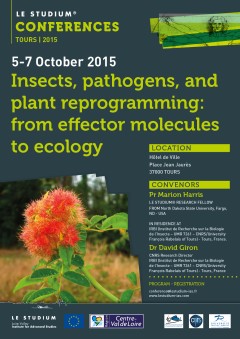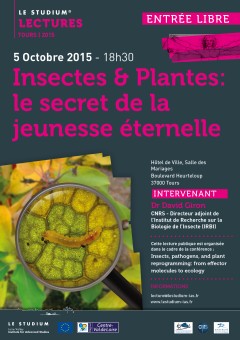Prof. Marion Harris

From
North Dakota State University - USA
In residence at
Insect Biology Research Institute (IRBI), University of Tours / CNRS - FR
Host Scientist
Prof. David Giron
PROJECT
Insect reprogrammers: From strategies for manipulating plants to agriculture
Plants constitute key nutritional resources for many organisms on Earth and protect these resources by enhancing interactions with mutualists while reducing interactions with antagonists. Interactions with different members of their ecological community can lead to a profound metabolic reconfiguration of the plant’s physiology, which favours beneficial organisms like symbionts and harms antagonists like pathogens or herbivores. Among the insect herbivores that attack plants, some species have evolved a peculiar feeding strategy that allows them to hijack the plant’s machinery for their own benefit. By ‘reprogramming' the plant genome, the insect forces the plant to create specialized nutritional resources that benefit the insect at the expense of the plant’s growth and reproduction. This attack strategy can have serious economic consequences in agroecosystems by reducing crop yield or quality. Mechanisms underlying this attack strategy and the plant’s options for effective defense remain largely unknown.
The research focuses on: 1. physiological modifications induced in susceptible and resistant plants; 2. changes in phytohormones that accompany these modifications; and 3. secreted salivary effectors that are produced by insect 'reprogrammers' to suppress defense responses and alter plant metabolic processes. Feeding strategies of a number of different plant-manipulating insects will be compared using an evolutionary framework to discover similarities and differences in their strategies for exploiting plants. Strategies used by insect ‘reprogrammers’ will also be compared to those of antagonistic microbes and nematodes that ‘reprogram’ the plant.
Knowledge gained from this research collaboration will contribute to new ideas for using natural plant traits to protect agricultural plants from biotic stress.
Publications
There is tremendous diversity of interactions between plants and other species. These relationships range from antagonism to mutualism. Interactions of plants with members of their ecological community can lead to a profound metabolic reconfiguration of the plants’ physiology. This reconfiguration can favour beneficial organisms and deter antagonists like pathogens or herbivores. Determining the cellular and molecular dialogue between plants, microbes, and insects, and its ecological and evolutionary implications is important for understanding the options for each partner to adopt an adaptive response to its biotic environment. Moving forward, understanding how such ecological interactions are shaped by environmental change and how we potentially mitigate deleterious effects will be increasingly important. The development of integrative multidisciplinary approaches may provide new solutions to the major ecological and societal issues ahead of us. The rapid evolution of technology provides valuable tools and opens up novel ways to test hypotheses that were previously unanswerable, but requires that scientists master these tools, understand potential ethical problems flowing from their implementation, and train new generations of biologists with diverse technical skills. Here, we provide brief perspectives and discuss future promise and challenges for research on insect–plant interactions building on the 16th International Symposium on Insect–Plant interactions (SIP) meeting that was held in Tours, France (2–6 July 2017). Talks, posters, and discussions are distilled into key research areas in insect–plant interactions, highlighting the current state of the field and major challenges, and future directions for both applied and basic research.
At the colonization site of a foreign entity, plant cells alter their trajectory of growth and development. The resulting structure – a plant gall – accommodates various needs of the foreigner, which are phylogenetically diverse: viruses, bacteria, protozoa, oomycetes, true fungi, parasitic plants, and many types of animals, including rotifers, nematodes, insects, and mites. The plant species that make galls also are diverse. We assume gall production costs the plant. All is well if the foreigner provides a gift that makes up for the cost. Nitrogen‐fixing nodule‐inducing bacteria provide nutritional services. Gall wasps pollinate fig trees. Unfortunately for plants, most galls are made for foes, some of which are deeply studied pathogens and pests: Agrobacterium tumefaciens, Rhodococcus fascians, Xanthomonas citri, Pseudomonas savastanoi, Pantoea agglomerans, ‘Candidatus’ phytoplasma, rust fungi, Ustilago smuts, root knot and cyst nematodes, and gall midges. Galls are an understudied phenomenon in plant developmental biology. We propose gall inception for discovering unifying features of the galls that plants make for friends and foes, talk about molecules that plants and gall‐inducers use to get what they want from each other, raise the question of whether plants colonized by arbuscular mycorrhizal fungi respond in a gall‐like manner, and present a research agenda.



